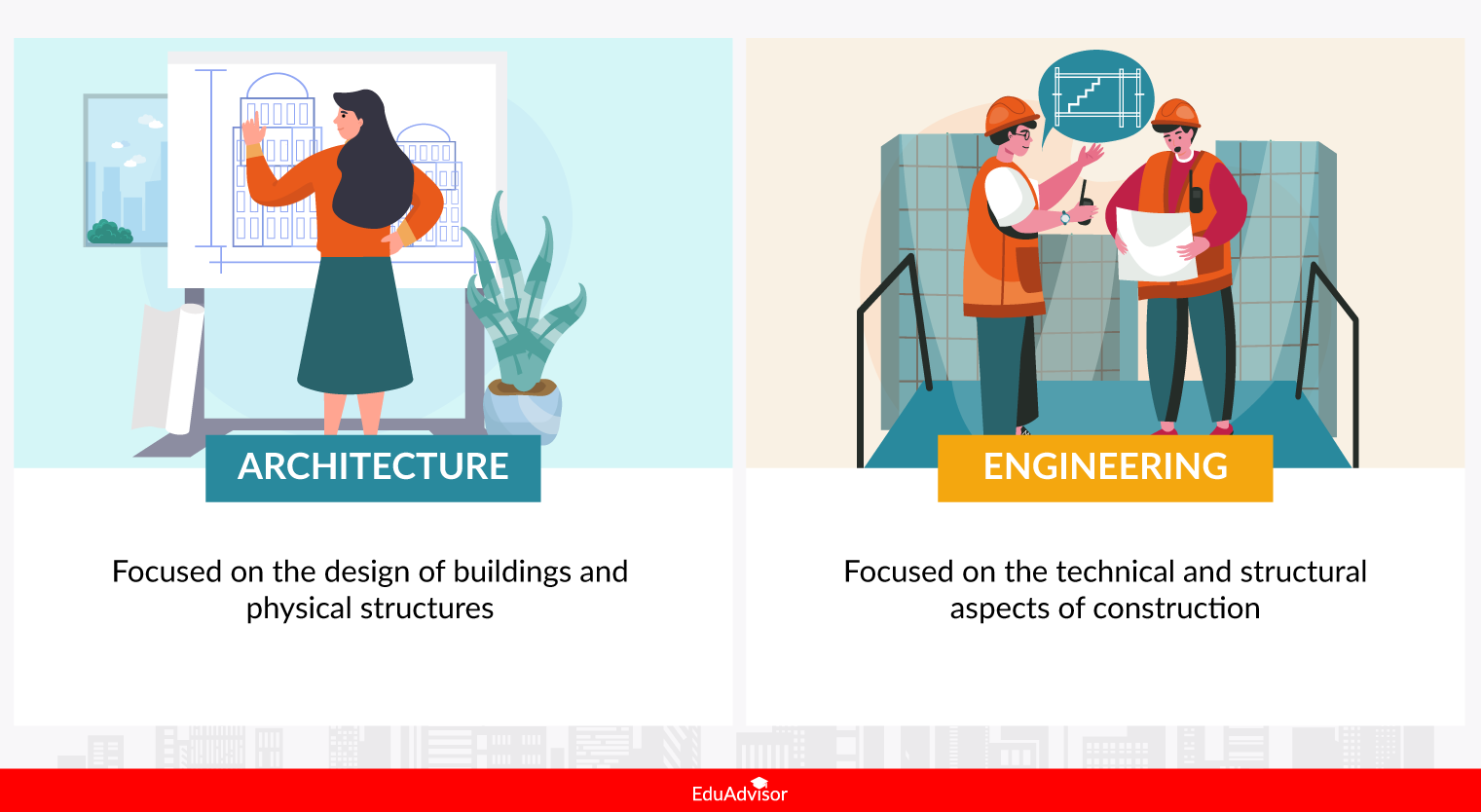Architecture vs Engineering: What’s the Difference?
Engineering and architecture are similar fields, but they have different focus. Find out the difference between architecture and engineering here.
Updated 23 May 2022

Whether it’s a house, a condo or a college campus, architects and engineers are both involved in the design and construction of the structure. While these two fields are related, they are distinct disciplines with different functions and goals.
If you’re considering a career in either architecture and engineering but aren’t sure which path to take, here are the key differences to take note of.
#1. Architecture is focused on design while engineering is about the execution of the project

Architecture is focused on the design of buildings and physical structures. A field that balances both art and science, architects ensure that their design is aesthetically-pleasing while being safe, functional and realistic.
Engineering, on the other hand, is a diverse field with numerous disciplines. Civil engineering is the most closely related to architecture, where the field specialises in the technical and structural aspects of construction. Civil engineers carry out the vision of architects by providing technical design recommendations, selecting the right structural materials, coordinating safety and regulatory compliance activities and directing construction work. Other engineers, such as electrical engineers for electrical systems and equipment, may also be involved.
To put it simply, architecture is more focused on the "art" and aesthetics of design while engineering is more focused on the science and how to bring the design to life.

Asia Pacific University of Technology & Innovation (APU)
Bachelor of Petroleum Engineering (Hons)
✓Accredited by the Board of Engineers Malaysia (BEM) and Washington Accord
#2. Engineering has a higher entry requirement compared to architecture

Compared to architecture, engineering is generally more stringent in its entry requirements.
An architecture programme typically asks for a credit in mathematics. For a diploma in architecture, the minimum entry requirement is 3Cs including mathematics in SPM. For an architecture degree, you will need a minimum of 2Cs including mathematics in STPM or equivalent.
To study engineering, you will not only need a credit in mathematics, but also a credit in a relevant science subject. An engineering diploma typically requires a minimum of 3Cs in SPM, including mathematics and one science subject. A degree in engineering usually requires 2Cs, which must include mathematics and a relevant science subject.

#3. Architecture and engineering have different study modules

An architecture student can expect a curriculum that focuses on both arts and science. You will not only learn about the history of architectural design, but also geometry and algebra as well as computer aided design. Your coursework will often invite you to come up with creative designs through the use of sound mathematical and scientific theories.
In contrast, an engineering student will often find themselves with a science and mathematics-focused curriculum. Your modules will include subjects such as advanced calculus, hydraulics, engineering dynamics and structural analysis.
So if you’re looking for a programme with a healthy balance between arts and science, architecture is the way to go. If you prefer to focus more on science and mathematical subjects, engineering is the better choice for you.
Apply for university with EduAdvisor
Secure scholarships and more when you apply to any of our 100+ partner universities.
Start now#4. Both fields are under the purview of different professional bodies

In Malaysia, the architecture field is regulated by the Board of Architects Malaysia, or Lembaga Arkitek Malaysia (LAM). To become a Professional Architect, you must graduate from an accredited and recognised architecture programme, pass the LAM professional exams and have the necessary working experience.
For engineering students, your field will be under the purview of the Board of Engineers Malaysia (BEM). To become a professional engineer, you will need to have accumulated at least 3 years of practical working experience and a pass in the BEM Professional Assessment Examination.
Both fields are heavily regulated and is one of the reasons why they are not interchangeable. You cannot be a professional architect without certification from LAM. The same applies to professional engineering roles and the BEM certification.

Asia Pacific University of Technology & Innovation (APU)
Bachelor of Petroleum Engineering (Hons)
✓Accredited by the Board of Engineers Malaysia (BEM) and Washington Accord
#5. Architecture and engineers play different roles in a construction project

Architects typically play a more active role during the pre-construction phase. They create the initial design plans, make changes and amendments based on the client’s wishes, and liaise with other personnel. They may remain involved during the construction period, but primarily to help with any redesign work.
Once a construction project begins, the engineer (or several, depending on the scale of the project) usually comes in. It is their responsibility to oversee and supervise the construction process. They are in charge of ensuring that the construction progresses smoothly. Their tasks include overseeing subcontractors, acting as on-site managers and a variety of other duties.

#6. Architects and engineers are experts at different areas

Another notable difference between architects and engineers is the type of work they can do.
Architects work primarily on buildings and physical structures such as homes, hospitals, skyscrapers and bridges. But that’s not all. Architects are designers too. They can branch into interior design and even design objects such as furniture, products and even cars.
Meanwhile, civil engineers do not only work on buildings and physical structures. There are many subdisciplines within civil engineering, including environmental engineering, transportation engineering and water resources engineering. Some engineers even specialise in highway engineering, a subset of transportation engineering.
Regardless of which you choose, both fields have plenty of prospects that go beyond construction sites.
In short, architecture and engineering may overlap but they are not the same thing. We hope that by highlighting the differences between the two, you will have a clearer idea of which field is better suited for you.






